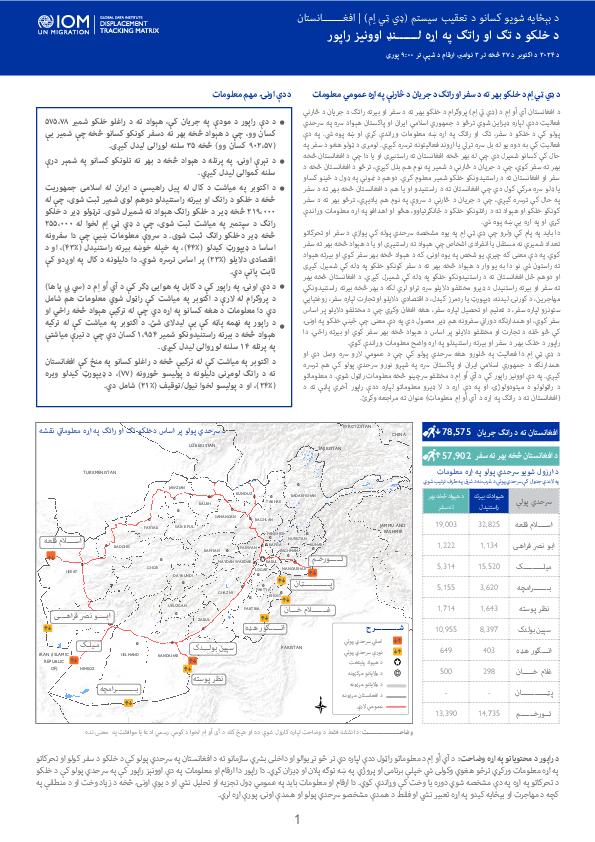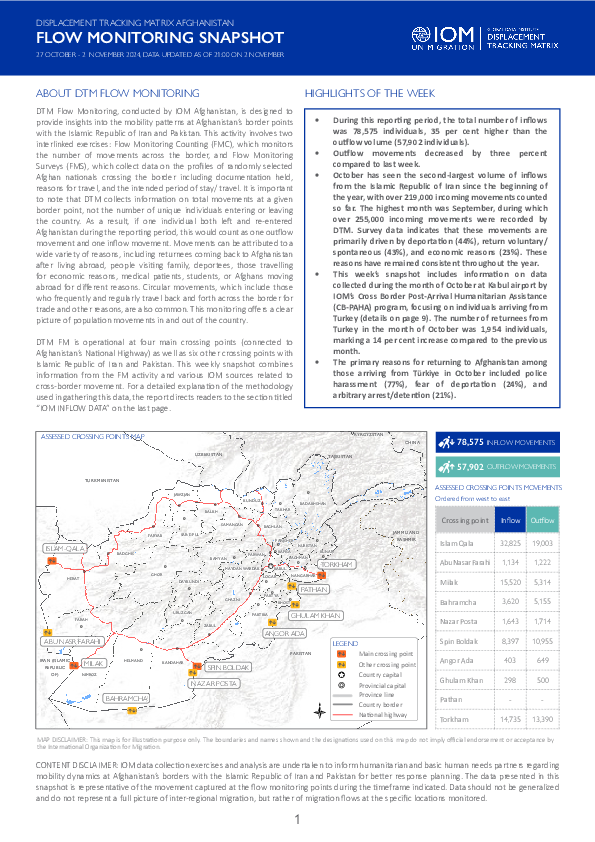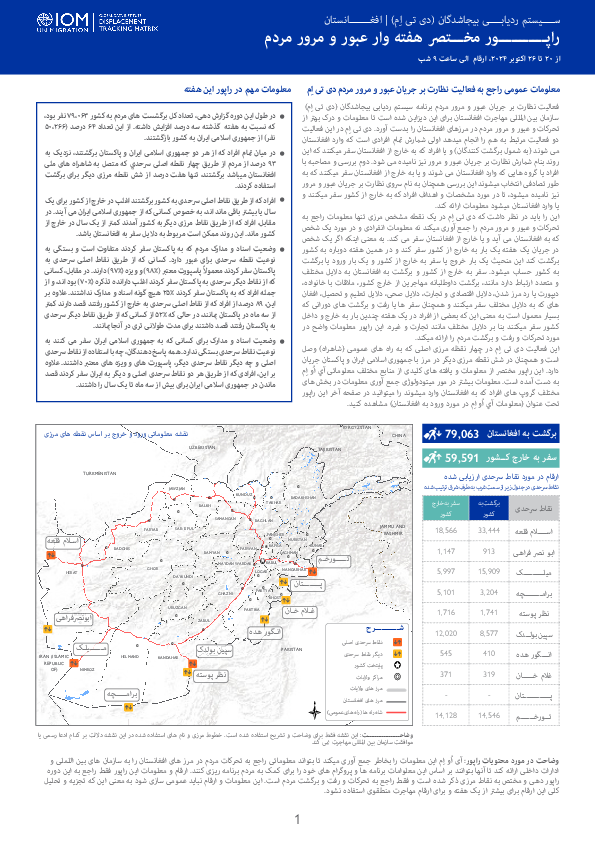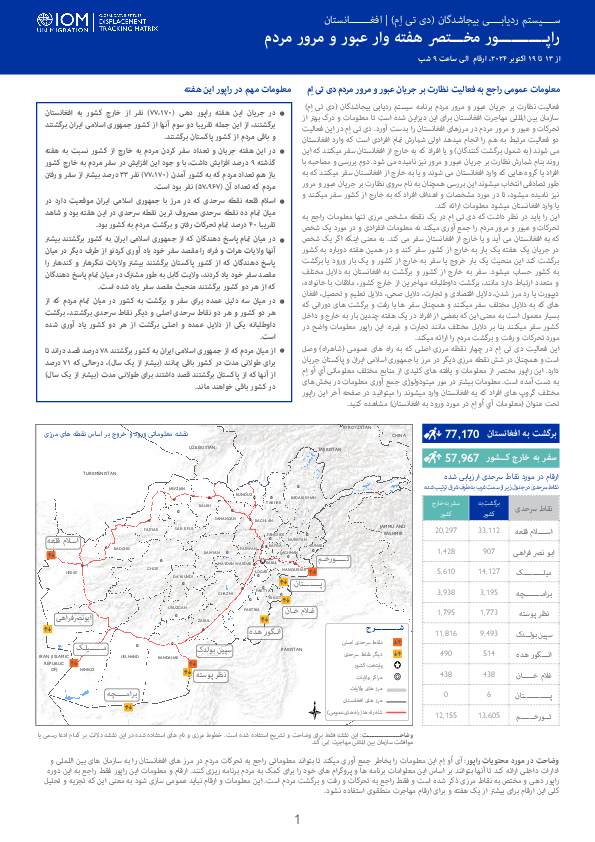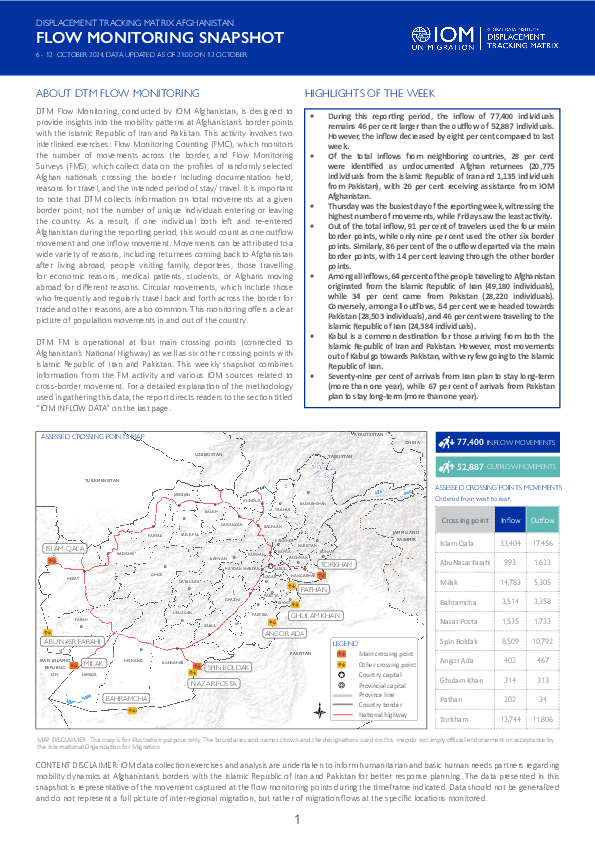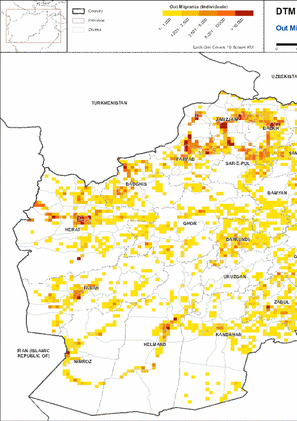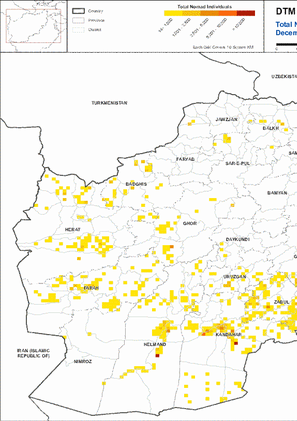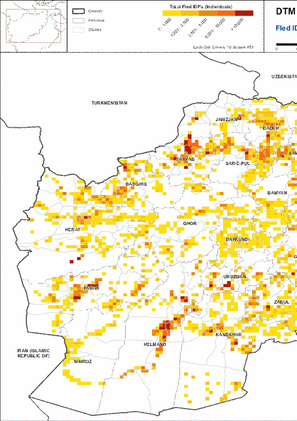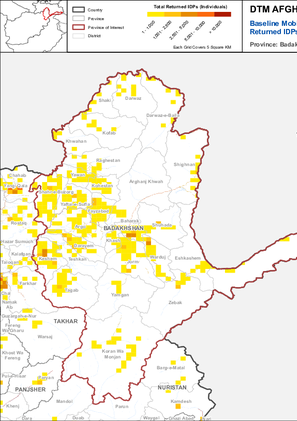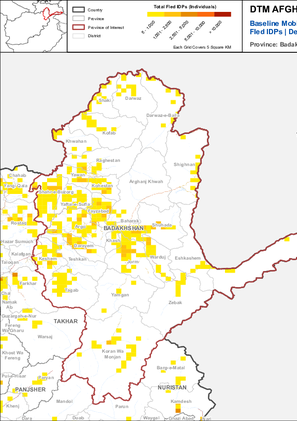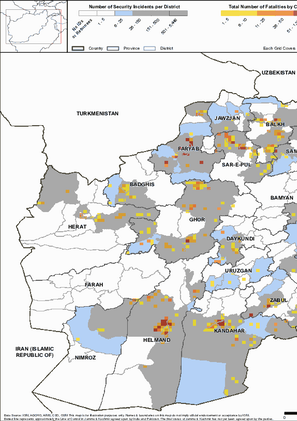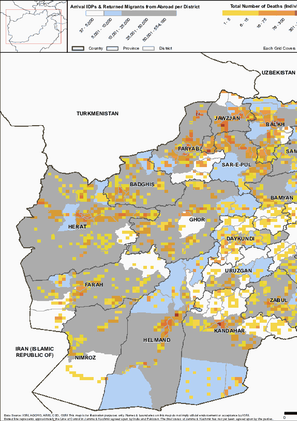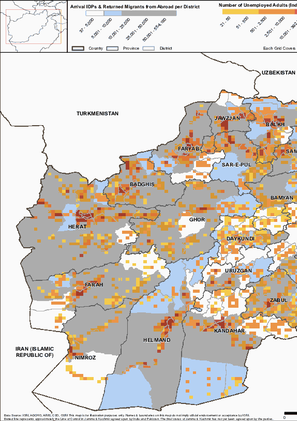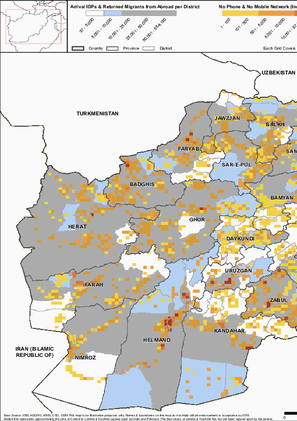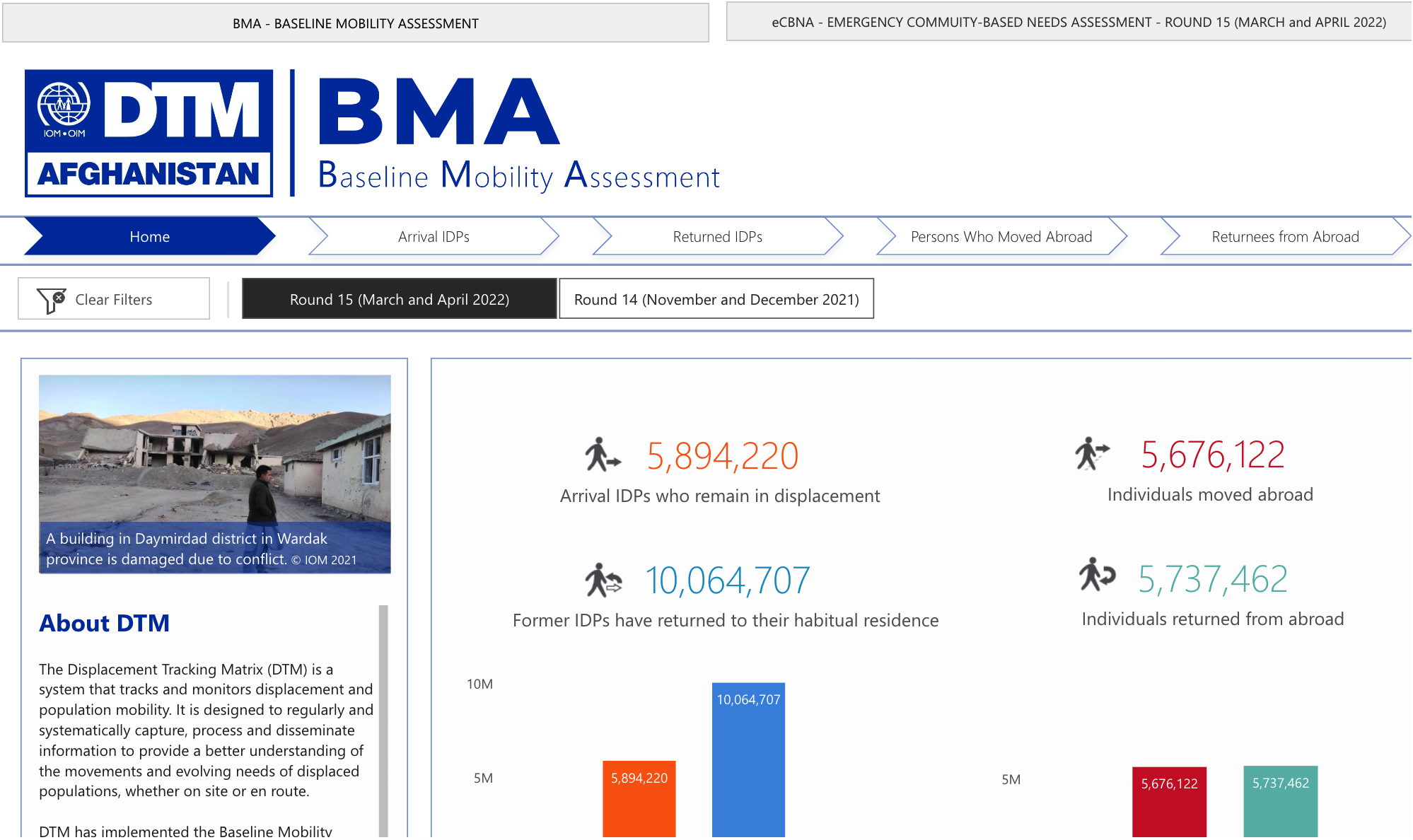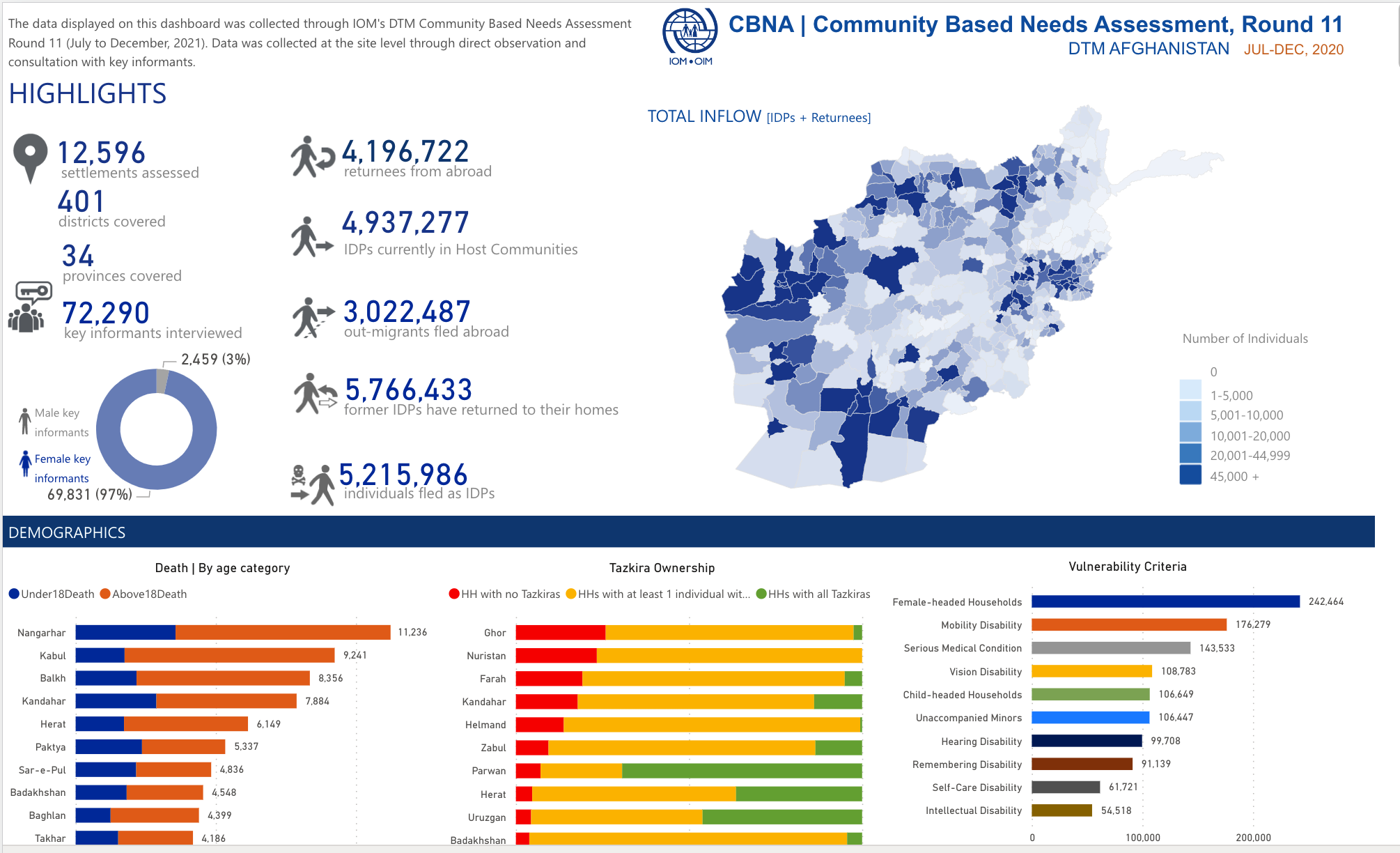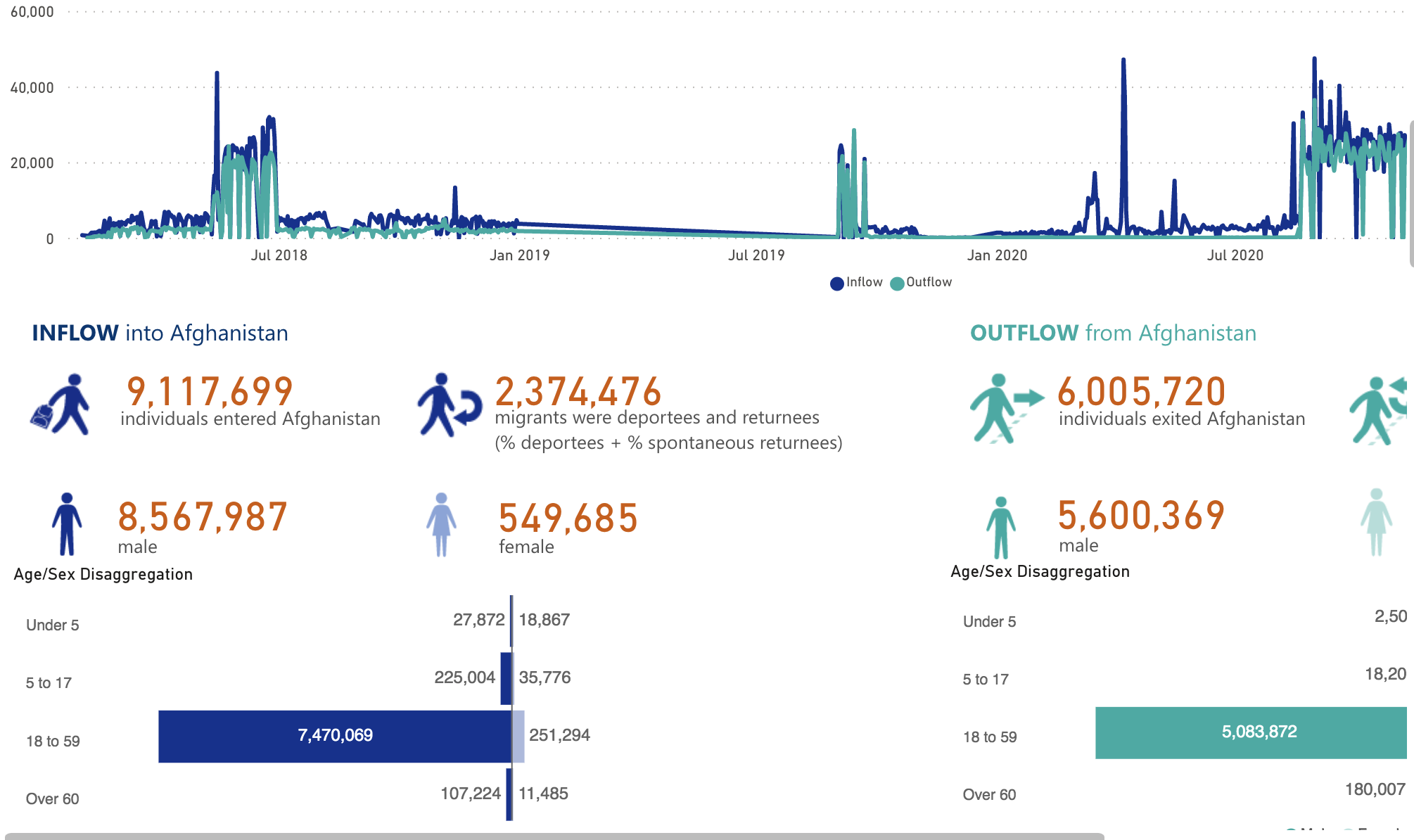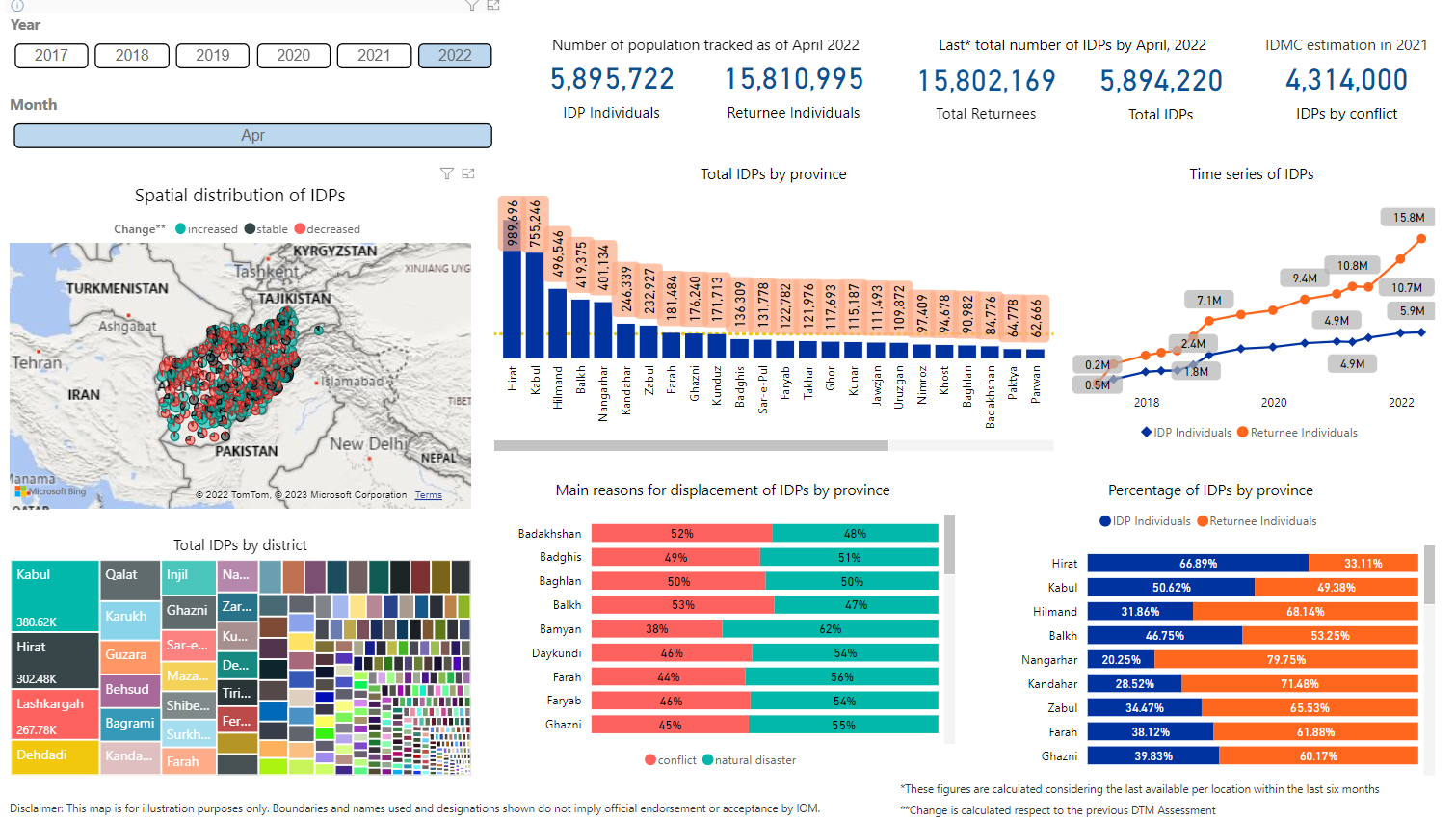-
Countries
-
Data and Analysis
-
Special Focus
-
Crisis Responses
Afghanistan
Afghanistan
Suivi des PDI
Mouvements de déplacement
4,187,000
IDMC 2023
cycle de collecte de données
À propos Afghanistan
The Displacement Tracking Matrix (DTM) is an information management system of tools and methodologies used to track and monitor displacement and population mobility. In Afghanistan, IOM activated the DTM programme in January 2017 in response to the substantial increase of Afghans returning home from neighbouring countries, as well as record levels of internal displacement. DTM in Afghanistan is designed to regularly and systematically capture, process and disseminate multi-layered information about the population sizes, locations, geographic distribution, movements, vulnerabilities, evolving multisectoral needs, and the drivers of migration of returnees, IDPs, migrants and mobile populations. DTM implements baseline mobility assessments, flow monitoring, registrations, and various migration surveys to provide an essential evidence base that enables decision-makers and humanitarian, reintegration and development partners to maximize resources and deliver efficient, better-targeted, mobility-sensitive and sustainable humanitarian; reintegration, community stabilization and development programming.
The value-added impact of DTM in Afghanistan is to inform action and results for people in need. DTM Afghanistan implements its activities at both the national and provincial levels. DTM works closely with other (IOM) programmes through referring identified populations in need of assistance at flow monitoring points to IOM’s Cross Border Return and Reintegration, Protection, Humanitarian Assistance, and Reintegration and Development (RADA) programmes. DTM Afghanistan also supports humanitarian partners and clusters, including WFP, FAO, UNHCR, IRC, DRC, NRC, and WHO, among many others, by providing emergency tracking updates in large-scale or sudden onset movements, such as emergency event tracking and drought response. Furthermore, stabilization and development actors, including IOM’s RADA programme, and the World Bank leverage DTM’s information to select priority communities and districts with higher concentrations of IDPs and returnees to receive reintegration and livelihoods assistance and improvements to core infrastructure and essential services. In support of health partners, including WHO, UNICEF, and the Humanitarian Health Cluster, DTM data informs the selection of priority, at-risk districts, border areas, communities, and health facilities in need of strengthened capacity, response, surveillance, and risk education for polio, TB, COVID-19, and other infectious diseases.
Contacter
Modher ALHAMADANI
Senior Programme Coordinator - DTM
malhamadani@iom.int
DTM AFGHANISTAN
DTMAFGHANISTAN@iom.int
Bailleurs de fonds
- Republic of Korea
- Norway
- CERF
- Canada
- Italy
- EU
- FCDO
افغانستان - د خلکو د تګ او راتګ په اړه لنډ راپور (۱۰ - ۱۶ نوامبر ۲۰۲۴) [PASHTO]
د افغانستان آي اُو اِم د (ډي تي اِم) پروګرام د خلکو بهر ته د سفر او بیرته راتګ د جریان د څارنې فعالیت ددې لپاره ډیزاین شوي ترڅو د جمهوري اسلامي ایران او پاکستان هېواد سره په سرحدي پولو کې د خلکو د سفر، تګ او راتګ په اړه ښه معلومات وړاندې کړي او ښه پوه شي.
افغانستان - راپور مختصر جریان عبور و مرور (۱۰ - ۱۶ نوامبر ۲۰۲۴) [DARI]
فعالیت نظارت بر جریان عبور و مرور مردم برنامه سیستم ردیابی بیجاشدگان (دی تی اِم) سازمان بین المللی مهاجرت افغانستان برای این دیزاین شده است تا معلومات و درک بهتر از تحرکات و عبور و مرور مردم در مرزهای افغانستان را بدست آورد.
Afghanistan - Flow Monitoring Snapshot (10 - 16 November 2024) [ENG]
DTM Flow Monitoring, conducted by IOM Afghanistan, is designed to provide insights into the mobility patterns at Afghanistan’s border points with the Islamic Republic of Iran and Pakistan.
افغانستان - د خلکو د تګ او راتګ په اړه لنډ راپور (۳ - ۹ نوامبر ۲۰۲۴) [PASHTO]
د افغانستان آي اُو اِم د (ډي تي اِم) پروګرام د خلکو بهر ته د سفر او بیرته راتګ د جریان د څارنې فعالیت ددې لپاره ډیزاین شوي ترڅو د جمهوري اسلامي ایران او پاکستان هېواد سره په سرحدي پولو کې د خلکو د سفر، تګ او راتګ په اړه ښه معلومات وړاندې کړي او ښه پوه شي.
افغانستان - راپور مختصر جریان عبور و مرور (۳ - ۹ نوامبر ۲۰۲۴) [DARI]
فعالیت نظارت بر جریان عبور و مرور مردم برنامه سیستم ردیابی بیجاشدگان (دی تی اِم) سازمان بین المللی مهاجرت افغانستان برای این دیزاین شده است تا معلومات و درک بهتر از تحرکات و عبور و مرور مردم در مرزهای افغانستان را بدست آورد.
Afghanistan - Flow Monitoring Snapshot (3 - 9 November 2024) [ENG]
DTM Flow Monitoring, conducted by IOM Afghanistan, is designed to provide insights into the mobility patterns at Afghanistan’s border points with the Islamic Republic of Iran and Pakistan.
افغانستان - د خلکو د تګ او راتګ په اړه لنډ راپور (۲۷ اکتوبر - ۲ نوامبر ۲۰۲۴) [PASHTO]
د افغانستان آي اُو اِم د (ډي تي اِم) پروګرام د خلکو بهر ته د سفر او بیرته راتګ د جریان د څارنې فعالیت ددې لپاره ډیزاین شوي ترڅو د جمهوري اسلامي ایران او پاکستان هېواد سره په سرحدي پولو کې د خلکو د سفر، تګ او راتګ په اړه ښه معلومات وړاندې کړي او ښه پوه شي.
افغانستان - راپور مختصر جریان عبور و مرور (۲۷ اکتوبر - ۲ نوامبر ۲۰۲۴) [DARI]
فعالیت نظارت بر جریان عبور و مرور مردم برنامه سیستم ردیابی بیجاشدگان (دی تی اِم) سازمان بین المللی مهاجرت افغانستان برای این دیزاین شده است تا معلومات و درک بهتر از تحرکات و عبور و مرور مردم در مرزهای افغانستان را بدست آورد.
Afghanistan - Flow Monitoring Snapshot (27 October - 2 November 2024) [ENG]
DTM Flow Monitoring, conducted by IOM Afghanistan, is designed to provide insights into the mobility patterns at Afghanistan’s border points with the Islamic Republic of Iran and Pakistan.
افغانستان - د خلکو د تګ او راتګ په اړه لنډ راپور (۲۰ - ۲۶ اکتوبر ۲۰۲۴) [PASHTO]
د افغانستان آي اُو اِم د (ډي تي اِم) پروګرام د خلکو بهر ته د سفر او بیرته راتګ د جریان د څارنې فعالیت ددې لپاره ډیزاین شوي ترڅو د جمهوري اسلامي ایران او پاکستان هېواد سره په سرحدي پولو کې د خلکو د سفر، تګ او راتګ په اړه ښه معلومات وړاندې کړي او ښه پوه شي.
افغانستان - راپور مختصر جریان عبور و مرور (۲۰ - ۲۶ اکتوبر ۲۰۲۴) [DARI]
فعالیت نظارت بر جریان عبور و مرور مردم برنامه سیستم ردیابی بیجاشدگان (دی تی اِم) سازمان بین المللی مهاجرت افغانستان برای این دیزاین شده است تا معلومات و درک بهتر از تحرکات و عبور و مرور مردم در مرزهای افغانستان را بدست آورد.
Afghanistan - Flow Monitoring Snapshot (20 -26 October 2024) [ENG]
DTM Flow Monitoring, conducted by IOM Afghanistan, is designed to provide insights into the mobility patterns at Afghanistan’s border points with the Islamic Republic of Iran and Pakistan.
افغانستان - د خلکو د تګ او راتګ په اړه لنډ راپور (۱۳ - ۱۹ اکتوبر ۲۰۲۴) [PASHTO]
د افغانستان آي اُو اِم د (ډي تي اِم) پروګرام د خلکو بهر ته د سفر او بیرته راتګ د جریان د څارنې فعالیت ددې لپاره ډیزاین شوي ترڅو د جمهوري اسلامي ایران او پاکستان هېواد سره په سرحدي پولو کې د خلکو د سفر، تګ او راتګ په اړه ښه معلومات وړاندې کړي او ښه پوه شي.
افغانستان - راپور مختصر جریان عبور و مرور (۱۳ - ۱۹ اکتوبر ۲۰۲۴) [DARI]
فعالیت نظارت بر جریان عبور و مرور مردم برنامه سیستم ردیابی بیجاشدگان (دی تی اِم) سازمان بین المللی مهاجرت افغانستان برای این دیزاین شده است تا معلومات و درک بهتر از تحرکات و عبور و مرور مردم در مرزهای افغانستان را بدست آورد.
Afghanistan - Flow Monitoring Snapshot (13 -19 October 2024) [ENG]
DTM Flow Monitoring, conducted by IOM Afghanistan, is designed to provide insights into the mobility patterns at Afghanistan’s border points with the Islamic Republic of Iran and Pakistan.
Afghanistan - Flow Monitoring Quarterly Report 3 (July - September 2024) [ENG]
Over the past several decades, frequent movements across the borders with the Islamic Republic of Iran and Pakistan characterized much of Afghanistan’s cross-border mobility dynamics.
افغانستان - د خلکو د تګ او راتګ په اړه لنډ راپور (۶ - ۱۲ اکتوبر ۲۰۲۴) [PASHTO]
د افغانستان آي اُو اِم د (ډي تي اِم) پروګرام د خلکو بهر ته د سفر او بیرته راتګ د جریان د څارنې فعالیت ددې لپاره ډیزاین شوي ترڅو د جمهوري اسلامي ایران او پاکستان هېواد سره په سرحدي پولو کې د خلکو د سفر، تګ او راتګ په اړه ښه معلومات وړاندې کړي او ښه پوه شي.
افغانستان - راپور مختصر جریان عبور و مرور (۶ - ۱۲ اکتوبر ۲۰۲۴) [DARI]
فعالیت نظارت بر جریان عبور و مرور مردم برنامه سیستم ردیابی بیجاشدگان (دی تی اِم) سازمان بین المللی مهاجرت افغانستان برای این دیزاین شده است تا معلومات و درک بهتر از تحرکات و عبور و مرور مردم در مرزهای افغانستان را بدست آورد.
Afghanistan - Flow Monitoring Snapshot (6 -12 October 2024) [ENG]
DTM Flow Monitoring, conducted by IOM Afghanistan, is designed to provide insights into the mobility patterns at Afghanistan’s border points with the Islamic Republic of Iran and Pakistan.
افغانستان - د خلکو د تګ راتګ په اړه لنډ راپور (۲۹ سپتمبر - ۵ اکتوبر ۲۰۲۴) [PASHTO]
د افغانستان آي اُو اِم د (ډي تي اِم) پروګرام د خلکو بهر ته د سفر او بیرته راتګ د جریان د څارنې فعالیت ددې لپاره ډیزاین شوي ترڅو د جمهوري اسلامي ایران او پاکستان هېواد سره په سرحدي پولو کې د خلکو د سفر، تګ او راتګ په اړه ښه معلومات وړاندې کړي او ښه پوه شي.
افغانستان - راپور مختصر جریان عبور و مرور (۲۹ سپتمبر - ۵ اکتوبر ۲۰۲۴) [DARI]
فعالیت نظارت بر جریان عبور و مرور مردم برنامه سیستم ردیابی بیجاشدگان (دی تی اِم) سازمان بین المللی مهاجرت افغانستان برای این دیزاین شده است تا معلومات و درک بهتر از تحرکات و عبور و مرور مردم در مرزهای افغانستان را بدست آورد.
Afghanistan - Flow Monitoring Snapshot (29 September - 5 October 2024) [ENG]
DTM Flow Monitoring, conducted by IOM Afghanistan, is designed to provide insights into the mobility patterns at Afghanistan’s border points with the Islamic Republic of Iran and Pakistan.
افغانستان - راپور مختصر جریان عبور و مرور (۲۲ - ۲۸ سپتمبر ۲۰۲۴) [DARI]
فعالیت نظارت بر جریان عبور و مرور مردم برنامه سیستم ردیابی بیجاشدگان (دی تی اِم) سازمان بین المللی مهاجرت افغانستان برای این دیزاین شده است تا معلومات و درک بهتر از تحرکات و عبور و مرور مردم در مرزهای افغانستان را بدست آورد.
افغانستان - د خلکو د تګ او راتګ په اړه لنډ راپور (۲۲ - ۲۸ سپتمبر ۲۰۲۴) [PASHTO]
د افغانستان آي اُو اِم د (ډي تي اِم) پروګرام د خلکو بهر ته د سفر او بیرته راتګ د جریان د څارنې فعالیت ددې لپاره ډیزاین شوي ترڅو د جمهوري اسلامي ایران او پاکستان هېواد سره په سرحدي پولو کې د خلکو د سفر، تګ او راتګ په اړه ښه معلومات وړاندې کړي او ښه پوه شي.
Pagination
Afghanistan - Flow Monitoring Counting (Since January 10 to November 23, 2024)
2024-11-23
<p>DTM Flow Monitoring, conducted by IOM Afghanistan, is designed to provide insights into the mobility patterns at Afghanistan’s border points with the Islamic Republic of Iran and Pakistan.&nbsp;</p><p>It is important to note that DTM collects information on total movements…
Afghanistan – Baseline Area Assessment B1 – Round 1
2024-02-29
<p>IOM Afghanistan launched the first round of the DTM Baseline Area Assessment B1 in January 2024 as part of its ongoing efforts to collect crucial data on population mobility dynamics, specifically displacement and returns. In particular, the B1 activity seeks to map the presence of mobile…
Afghanistan - Baseline Assessment, Settlement Level Dataset, Round 16 (September-December 2022)
2022-12-31
This file contains data from DTM Afghanistan's 16th round of the Baseline Mobility Assessment (BMA), which was conducted between September and December 2022. DTM has been conducting the BMA in Afghanistan since 2016 to track mobility, provide information on population estimates, locations and…
Afghanistan – Community-Based Needs Assessment, Settlement Level Dataset, Round 16 (September-December 2022)
2022-12-31
<p>The CBNA is an integral component of DTM's Baseline Mobility Assessment (BMA), which (in a jointly released dataset) tracks mobility and displacement. The objective of the CBNA is to provide a baseline for programmatic priorities and geographical targeting of assistance, by supplying…
Afghanistan - Baseline Assessment, Settlement Level, Round 15 (March-April 2022)
2022-04-30
A baseline assessment is a sub-component of mobility tracking. It aims to collect data on IDP, migrant and returnee population presence in a defined administrative area of the country. This dataset contains information by settlement. Settlement is the lowest unit of observation used in Afghanistan.
Afghanistan - Emergency Community-Based Needs Assessment - Round 15 (March-April 2022)
2022-04-30
Since December 2019, the Community-Based Needs Assessment (CBNA)has been included as a standard component of the Baseline Mobility Assessment (BMA) exercise as a way to provide a more comprehensive view of multi-sectoral needs in settlements hosting IDPs and returnees. In Round 15, the DTM team in…
Afghanistan - Baseline Assessment, District Level, Round 15 (March-April 2022)
2022-04-30
A baseline assessment is a sub-component of mobility tracking. It aims to collect data on IDP, migrant and returnee population presence in a defined administrative area of the country. This dataset presents a summary at the district level of data collected by DTM in Afghanistan.
Afghanistan - Baseline Assessment Settlement Round 14
2021-12-31
A baseline assessment is a sub-component of mobility tracking. It aims to collect data on IDP, migrant or returnee population presence in a defined administrative area of the country. This dataset contains information by settlement. Settlement is the lowest unit of observation used in Afghanistan
Afghanistan - Community Based Needs Assessment, Round 14 (Nov-Dec 2021)
2021-12-31
A Community-Based Needs Assessment (CBNA), intended as an integral component of DTM's Baseline Mobility Assessment to provide a more comprehensive view of multi-sectoral needs in settlements hosting IDPs and returnees.
Afghanistan - Baseline Assessment District Round 14
2021-12-31
A baseline assessment is a sub-component of mobility tracking. It aims to collect data on IDP, migrant or returnee population presence in a defined administrative area of the country. This dataset presents a summary at the district level of data collected by DTM in Afghanistan.
Afghanistan - Community Based Needs Assessment (April—June 2021)
2021-06-30
A Community-Based Needs Assessment (CBNA), intended as an integral component of DTM's Baseline Mobility Assessment to provide a more comprehensive view of multi-sectoral needs in settlements hosting IDPs and returnees.
Afghanistan - Baseline Assessment District Round 13
2021-06-30
A baseline assessment is a sub-component of mobility tracking. It aims to collect data on IDP, migrant or returnee population presence in a defined administrative area of the country. This dataset presents a summary at the district level of data collected by DTM in Afghanistan.
Afghanistan - Baseline Assessment Settlement Round 13
2021-06-30
A baseline assessment is a sub-component of mobility tracking. It aims to collect data on IDP, migrant or returnee population presence in a defined administrative area of the country. This dataset contains information by settlement. Settlement is the lowest unit of observation used in Afghanistan
Afghanistan - Baseline Assessment District Round 12
2021-03-31
A baseline assessment is a sub-component of mobility tracking. It aims to collect data on IDP, migrant or returnee population presence in a defined administrative area of the country. This dataset presents a summary at the district level of data collected by DTM in Afghanistan.
Afghanistan - Community Based Needs Assessment (January—March 2021)
2021-03-31
A Community-Based Needs Assessment (CBNA), intended as an integral component of DTM's Baseline Mobility Assessment to provide a more comprehensive view of multi-sectoral needs in settlements hosting IDPs and returnees.
Afghanistan — Baseline Mobility Assessment Summary Results (January—March 2021)
2021-03-31
A baseline assessment is a sub-component of mobility tracking. It aims to collect data on IDP, migrant or returnee population presence in a defined administrative area of the country. This dataset presents a summary at the district level of data collected by DTM in Afghanistan.
Afghanistan - Baseline Assessment Settlement Round 12
2021-03-31
A baseline assessment is a sub-component of mobility tracking. It aims to collect data on IDP, migrant or returnee population presence in a defined administrative area of the country. This dataset contains information by settlement. Settlement is the lowest unit of observation used in Afghanistan
Afghanistan - Baseline Assessment District Round 11
2020-12-31
A baseline assessment is a sub-component of mobility tracking. It aims to collect data on IDP, migrant or returnee population presence in a defined administrative area of the country. This dataset presents a summary at the district level of data collected by DTM in Afghanistan.
Afghanistan - Community Based Needs Assessment (July—December 2020)
2020-12-31
A Community-Based Needs Assessment (CBNA), intended as an integral component of DTM's Baseline Mobility Assessment to provide a more comprehensive view of multi-sectoral needs in settlements hosting IDPs and returnees.
Afghanistan - Baseline Assessment Settlement Round 11
2020-12-31
A baseline assessment is a sub-component of mobility tracking. It aims to collect data on IDP, migrant or returnee population presence in a defined administrative area of the country. This dataset contains information by settlement. Settlement is the lowest unit of observation used in Afghanistan
Pagination
AFG-DTM-District-Out-Flow-To-Europe-Overview-December2021
This map provides information on Outflow to Europe (Afghans who moved to non-neighboring countries) during period of 2012 till December 2021.
AFG-DTM-District-Arrival-IDPs-Overview-December2021
This map provides information on Arrival IDPs (IDPs from other location currently residing in an assessed village) during period of 2012 till December 2021.
AFG-DTM-District-Out-Migrants-Overview-December2021
This map provides information on Out Migrants (Afghans who moved or fled abroad) During period of 2012 till December 2021.
AFG-DTM-District-Returned-IDPs-Overview-December2021
This map provides information on Returned IDPs (Afghans from an assessed village who had fled as IDPs in the past and have now returned home) During period of 2012 till December 2021.
AFG-DTM-District-Returnees-from-Abroad-Overview-December2021
This map provides information on Returnees from Abroad (Afghans who had fled abroad for at least 6 months and have now returned to Afghanistan) During period of 2012 till December 2021.
AFG-DTM-District-Total-Nomads-Individuals-Overview-December2021
This map provides information on Total Nomads Individuals during period of 2012 till December 2021.
AFG-DTM-District-Total-Nomads-Families-Overview-December2021
This map provides information on Total Nomads Families during period of 2012 till December 2021.
AFG-DTM-District-Total-Inflow-Overview-December2021
This map provides information on Total inflow (Returnees from Abroad + Arrival IDPs) during the period from 2012 through December 2021.
AFG-DTM-District-Total-Refugee-Individuals-Overview-December2021
This map provides information on Total Refugee Individuals during period of 2012 till December 2021.
AFG-DTM-District-Total -Refugee-Families-Overview-December2021
This map provides information on Total Refugee Families during period of 2012 till December 2021.
AFG-DTM-District-Total-CB-Tribal-Individuals-Overview-December2021
This map provides information on Total Cross Border Tribal Individuals during period of 2012 till December 2021.
AFG-DTM-District-Total-CB-Tribal-Families-Overview-December2021
This map provides information on Total Cross Border Tribal Families during period of 2012 till December 2021.
Afghanistan - District Map - Fled IDPs - December 2021
This map provides information on Fled IDPs (Afghans from an assessed village who fled as IDPs to reside elsewhere in Afghanistan) During period of 2012 till December 2021.
Afghanistan — Provincial Map — Total Inflow (Arrival & Returned Migrants) — December 2021
This combined map provides information on Total Inflow (Arrival & Returned Migrants) at the provincial level during the period of 2012 - December 2021.
Afghanistan — Provincial Map — Returned Migrants from Abroad — December 2021
This combined map provides information on Returned Migrants from Abroad at the provincial level during the period of 2012 - December 2021.
Afghanistan — Provincial Map — Returned IDPs — December 2021
This combined map provides information on Returned IDPs at the provincial level during the period of 2012 - December 2021.
Afghanistan — Provincial Map — Out Migrants — December 2021
This combined map provides information on Out Migrants at the provincial level during the period of 2012 - December 2021.
Afghanistan — Provincial Map — Fled IDPs — December 2021
This combined map provides information on Fled IDPs at the provincial level during the period of 2012 - December 2021.
Afghanistan — Provincial Map — Arrival IDPs — December 2021
This combined map provides information on Arrival IDPs, on provincial level during the period of 2012 - December 2021.
AFG_DTM_December2021_CBNA_Security_Incidents_and_Fatalities_in_Last_6_Months_Overview_By_District
This map provides information on total number of security incidents and fatalities in the last 6 months in villages assessed under Community Based Needs Assessment during the period from 2012 through December 2021.
AFG_DTM_December2021_CBNA_Number_of_Deaths_in_Last_3_Months_Overview_By_District
This map provides information on total number of deaths in the last 3 months in villages assessed under Community Based Needs Assessment during the period from 2012 through December 2021.
AFG_DTM_December2021_CBNA_Number_of_Unemployed_Adults_(18+)_Overview_By_District
This map provides information on number of unemployed adults (18+) in villages assessed under Community Based Needs Assessment during the period from 2012 through December 2021.
AFG_DTM_December2021_CBNA_No_Phone_&_No_Mobile_Network_Overview_By_District
This map provides information on individuals who do not have access to phone or mobile network in villages assessed under Community Based Needs Assessment during the period from 2012 through December 2021.
AFG_DTM_December2021_CBNA_No_Access_to_Markets_Overview_By_District
This map provides information on individuals who do not have access to markets in villages assessed under Community Based Needs Assessment during the period from 2012 through December 2021.








